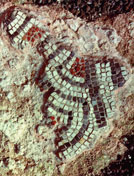
Archaeological Site
Antiquarium
 The villa had coloured mosaic floors and walls painted in various colours, hot air heating and glass in the windows, while the large hexagonal garden was probably decorated with marble statues, some of which dated back to Imperial times. These were probably inherited pieces or part of a collection of sculptures, which at the time only very rich families could afford. The Antiquarium contains some of these objects found during the excavations.
The villa had coloured mosaic floors and walls painted in various colours, hot air heating and glass in the windows, while the large hexagonal garden was probably decorated with marble statues, some of which dated back to Imperial times. These were probably inherited pieces or part of a collection of sculptures, which at the time only very rich families could afford. The Antiquarium contains some of these objects found during the excavations.
Archaeologists also discovered that this huge villa had undergone restoration and renovation work during its lifetime, probably in an effort to make it more luxurious and comfortable, or perhaps to bring it in line with the trends of the time. After it was destroyed, the remaining walls were used to build the huts of a small Early Medieval village.
By following the route set out in the Antiquarium, you can take a trip back in time to discover this fascinating place, which is steeped in history, personalities and interesting events linking Palazzo Pignano with the history of other places in the Eastern and Western Roman Empire.










